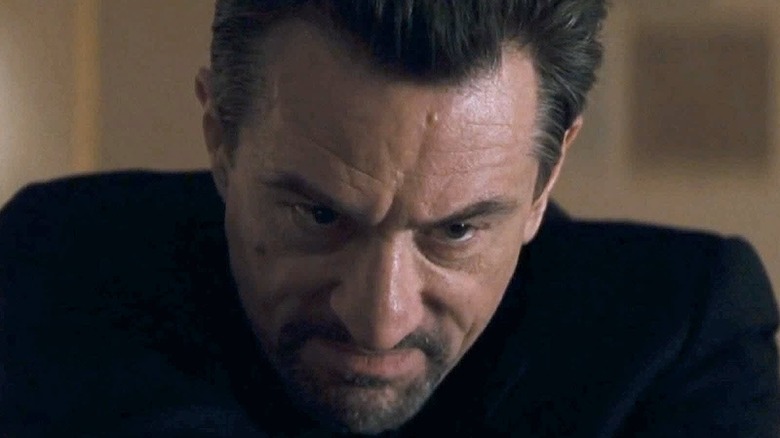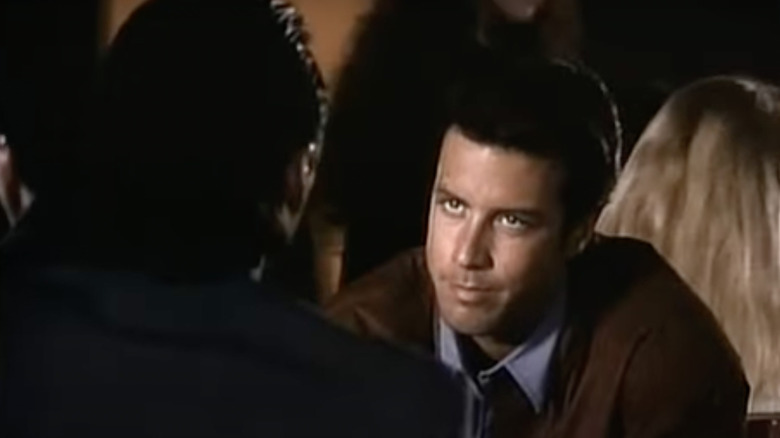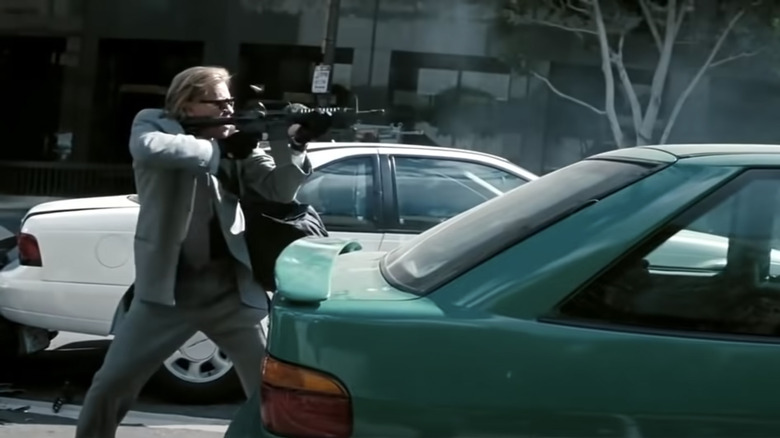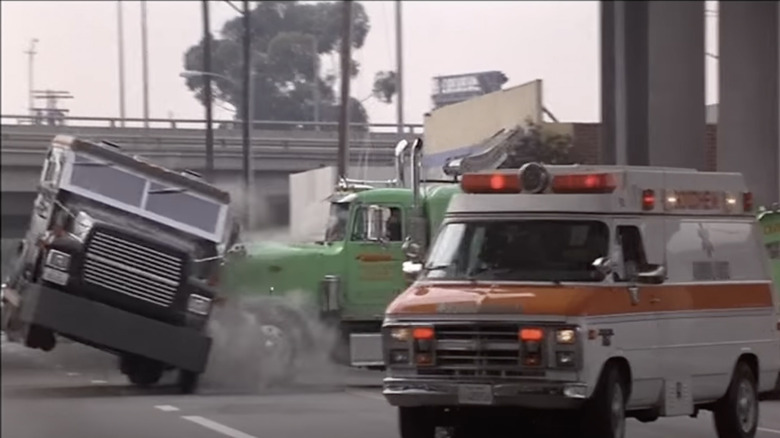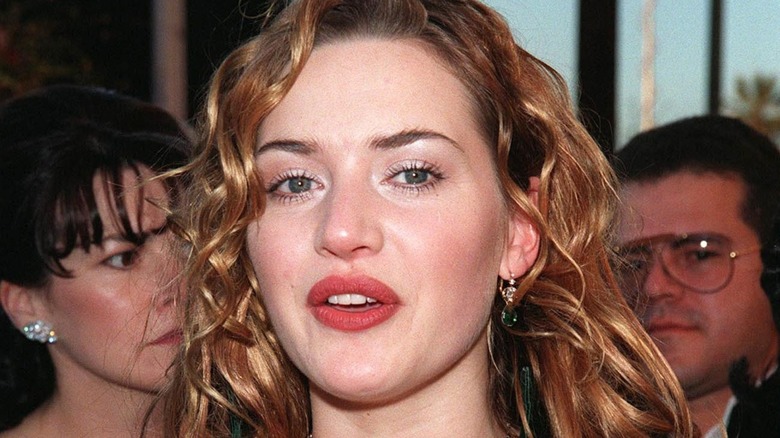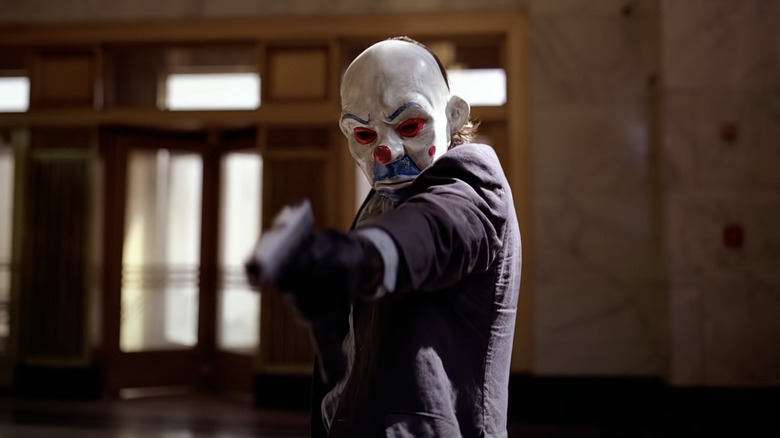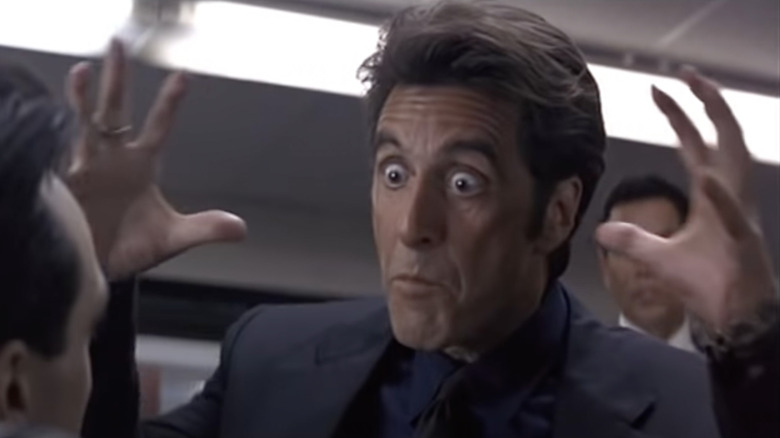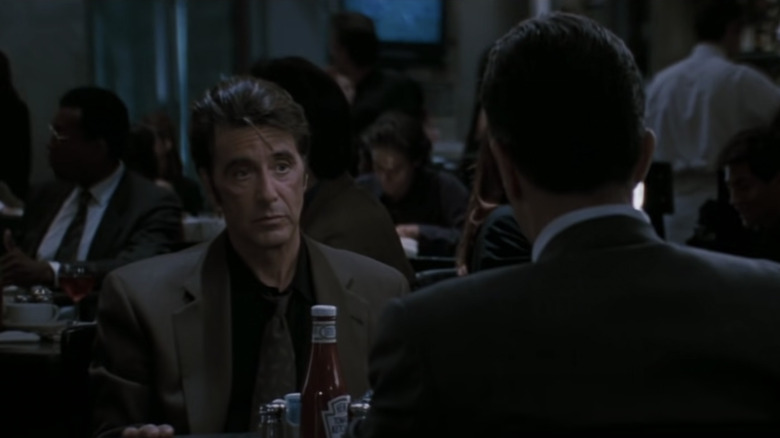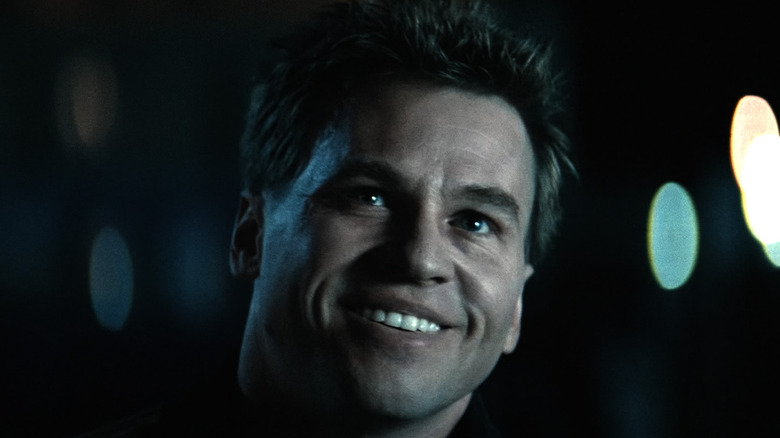Heat's Journey From A Real Heist To Hollywood History
A highly-publicized, highly-anticipated selling point upon its release, "Heat" marked the first time two of the most renowned actors in the history of cinema — Robert De Niro and Al Pacino — were paired together on-screen. While 1974's "The Godfather Part II" had earned them both Oscar nominations, they didn't have any scenes together in that film.
Director Michael Mann, famed for his commitment to visual realism, factual storytelling and in-depth explorations of the psychology of the criminal mind, was the perfect man to do it. The result still stuns: a thrilling, complex tale of cops and robbers, crackling with crisp dialogue and incomparable (though many have tried) action sequences.
Its plot moves briskly, back and forth between about a dozen key characters; Val Kilmer, Jon Voight, Tom Sizemore, Dennis Haysbert, Ashley Judd, Amy Brenneman, Natalie Portman, Hank Azaria, Danny Trejo and Henry Rollins all get a chance to shine. But leading them all is Pacino's detective Vincent Hanna and De Niro's master thief Neil McCauley — whose internal motivations are more similar (and self-destructive) than either would like to admit.
What distinguishes "Heat" from other heist films is not only its thrilling cat-and-mouse plot, but also its character study, focusing on each character's personal and professional personas to the point where Haysbert's crook-turned-cook Donald — arguably the 8th or 9th most important character in the film — has more of a rich, nuanced, complicated storyline than you see most movies give its leading man.
Hailed as one of the most important movies of its genre — influencing other artists to create films, novels, music, and video games — the movie somehow did not win any significant award nominations upon its release. As we feel the heat coming around the corner, let's walk out on this introduction and venture into how this classic heist-thriller film came to be.
Heat is a remake of another Michael Mann movie
Amidst an impressive filmography spanning several decades, "Heat" is the only film that director Michael Mann has made twice. Mann had written an early draft in 1979, without any intention of directing it at the time .Throughout the 1980s, there were a few unsuccessful attempts to get the movie made, including one in which Mann's screenplay was offered to "48 Hours" director Walter Hill, who turned it down.
"Walter Hill and I have been friends since 1972. This is a small community and we talked to each other yesterday. Our families are close," Mann said in a 2017 interview. "He would have been a terrific choice if he wanted to direct it. It wasn't a matter of approaching a stranger. I know the way Walter thinks and I know his work very, very intimately. And, that's what that decision of approaching him was based on."
Mann condensed his draft by roughly 40 percent, turning it into a pilot episode for a television series that toyed with names like "L.A. Crime Wave" and "Made in L.A" before finally being produced under the title "L.A. Takedown." He shot the pilot in 18 days with only 10 for pre-production — less than ideal conditions for a filmmaker whose meticulous, time-consuming productions typically yield layered, complex stories. For comparison, when he remade "L.A. Takedown" as "Heat," he received a 107-day shooting schedule following six-months of pre-production.
The network (NBC) wanted to recast lead actor Scott Plank (who played Vincent Hanna), to which Mann objected, ultimately leading the network to pass. Mann then repurposed the pilot into a 90-minute feature-length television film of the same name, broadcast on NBC in 1989.
It wasn't all for nothing, since the television film gave Mann a clearer idea of how he wanted to structure his original story. In the early 1990's, he showed this newly-reimagined script to producer Art Linson, who suggested casting De Niro and Pacino as the opposing leads. Linson gave Mann's script to De Niro, who in turn showed it to Pacino, and the rest is history.
The cast and crew's devotion to realism
Long before Keanu Reeves' John Wick gun training video made the idea of actors going through demanding training for action scenes mainstream, Mann had long insisted that his actors go through intensive weapons and combat training for his films. This included "Heat," whose cast underwent three months of weapons training, designed by British ex-special air service sergeant Andy McNab and technical weapons trainer Mick Gould.
Mann, who had famously spent time at Folsom Prison for his debut film "The Jericho Mile," reportedly returned with "Heat" actors to help research their roles. Even though getting permissions for locations was challenging — especially for the LAX airport scene at the film's climax — the entire movie was shot on location, spread across 95 different locales.
The gunshots in the shootout scene were all authentic sounds, recorded during the filming of the shootout scene, rather than added in post-production like most films (via YouTube). This, along with the decision to omit the use of music or background score, is why the shootout scene is regarded to be the most authentic of its kind, as the long, loud echoes of the gunshots add to the eerie, realistic horrors of gun violence taking place in the scene.
The heist scenes inspired a few real-life robberies
Although it is often remarked that truth is stranger than fiction, they often work in tandem to influence one another. "Heat" is noted for its realism in practically all aspects, particularly the modus-operandi of the heists that occur through the film. This is thanks to the real-life influences behind it — all the individuals, their stories, and the slew of unconnected real-life robberies that served as inspiration for Mann.
The film's fiction, however, did unintentionally have the effect of influencing a number of actual events, demonstrating the complex circular relationship between truth and fiction. Copycat "Heat" armored car robberies have been reported not only in the US, but also in South Africa, Colombia, Denmark, and Norway in the years since its release. Justice Malala, writing for Financial Mail in 2005, remarked after one such robbery: "If the police had an iota of intelligence, they would be scouring video shops ... to check on who had rented 'Heat' these past few days."
In Cali, Colombia in 2003, masked robbers drove a bus into an armored van; they stole $350,000 in cash, getting away in less than 20 minutes.
Perhaps closest to the film's events, however, was the all-too-real 1997 North Hollywood shoot-out, which made national headlines after portions were broadcast on live television. Two men robbed a Bank of America in North Hollywood and then, heavily fortified in body armor and carrying automatic weapons, engaged the police in a lengthy, protracted, daytime shootout on the streets of Los Angeles. The pair — both killed in the shootout — were later identified as Larry Phillips Jr. and Emil Mătăsăreanu, two bodybuilders who had bonded over their love of heist films, including "Heat."
Redouane Faid, a French gangster who carried out numerous armed robberies, jewel thefts, and extortions, has cited crime movies like "Reservoir Dogs," "Scarface," and "Heat" as inspiration for his criminal career. He even told director Michael Mann at a press conference in 2009 that the auteur was Faid's "technical adviser, a college teacher, a kind of mentor." Faid has been known to incorporate "homages" to Mann and "Heat" in his crimes.
What the cast almost looked like
It's always fun to imagine how favorite movies might appear if different actors were cast, even if "Heat" might be one of the most perfectly-cast films of all time. Since the invention of Deepfakes, fans (such as YouTuber Shamook) have indulged imaginations by overlaying the faces of other actors on those of iconic movie characters — examining what, say, Brad Pitt might have been like as Jason Bourne.
Like any other big Hollywood film, the producers of "Heat" considered multiple casting combinations and backups — including for De Niro and Pacino roles, just in case either actor fell out of the project.
You may have heard that Keanu Reeves nearly played the Val Kilmer role; Mann shot that old rumor down in a 2021 "Rewatchables" podcast episode. But Mann did reveal that he considered casting Kate Winslet for the role of Lauren — the stepdaughter of Pacino's Vincent Hanna, ultimately played by Portman.
Mann also denied rumors of James Caan and Michael Madsen being in the running for the film. Over the years, other rumored contenders have included Harrison Ford, Mel Gibson, Nick Nolte, Jeff Bridges, and Don Johnson, but Mann and the film's producers have neither confirmed nor denied.
Heat's influence on The Dark Knight
"The Dark Knight" is regarded as one of the best superhero movies of all time, possibly one of the best films ever made, for its exploration into nuanced moral dilemmas and characterizations skillfully woven within a well-made genre piece. It went on to revolutionize how audiences would perceive superhero films, and was hailed as an inspiration by numerous filmmakers, including Sam Mendes for "Skyfall" (via Collider), Ryan Coogler for "Black Panther" (via ScreenRant), and the creators of the CW television series "Arrow" (per Film School Rejects).
But the acclaimed superhero film was influenced itself by Michael Mann's "Heat," which "Dark Knight" director Christopher Nolan cites as a major influence not just for his film, but for himself as a filmmaker. Among the many movies that Nolan made his cast and crew watch in preparation for "The Dark Knight," a prominent one was "Heat" (via NoFilmSchool).
As this YouTube video by Glass Distortion illustrates, the influences of "Heat" on "The Dark Knight" are not only visually apparent — with Nolan's choices of camera techniques, shot composition, color tones, and an overall representation of a milieu (Los Angeles in "Heat," Chicago doubling for Gotham City in the "The Dark Knight") — but the two films are also thematically similar, with the duality of Vincent Hanna and Neil McCauley (cop and criminal) becoming the duality of Batman and The Joker.
In 2016, Nolan moderated a retrospective panel for of "Heat" with Mann, Pacino and De Niro for the Academy of Motion Picture Arts and Sciences. "It's just an American masterpiece," he said in his opening remarks. "And quite an incredible piece of work that I've drawn inspiration from, and filmmakers o my generation have drawn inspiration from, in the years since it was released."
Vincent Hanna's cocaine habit
While Pacino received praise for his portrayal as Vincent Hanna, a detective who struggles to strike a balance between his personal and professional lives, audiences and critics alike seemed appreciably amused by what felt like Pacino's most "over-the-top" line readings since Tony Montana. Characterized by erratic, unpredictable outbursts, Hanna seemed like a man on the edge — or perhaps, on something else.
Pacino's decision to take his "Heat" character to such heights was subsequently questioned after the film's release. In the film, there is little explanation as to why his character frequently behaves like an enraged Jim Carrey — interrogating Azaria (something that genuinely scared him), getting agitated about Ralph watching his television, or repeatedly yelling "Gimme all you got!" during his confrontation with his informant.
In 2016, Pacino finally fessed up. "I've always wanted to say it, just so you know where some of the behavior's coming from," Pacino revealed during a screening of the film's 4K restoration. Citing a brief shot that was ultimately omitted from the film, the Oscar winner says Hanna was supposed to be a character with substance abuse issues. "The character I played is a guy, he's been around, he's done a lot of stuff. And he also chips cocaine."
As seen in the "Making of Heat" video, Pacino attributed these largely behind-the-scenes character decisions to a need to come in at a different level than his calm, composed co-star. "I thought I would need to be a little bit more hyper than Robert's [De Niro] character. We came up with the idea that my character chipped cocaine," he said. "We sort of formulated [him] to be that kind of person so that every once in a while he would explode ... it's not in the picture but that's part of what motivated him from time to time, was that he was a little high."
The coffee shop scene was unrehearsed
From the moment the film was released, the most highly-anticipated scene was the coffee shop sitdown, finally putting Pacino and De Niro opposite each other. It might seem unreal for a scenario to transpire where two forces from the opposite sides of the law sit down for a discussion that doesn't take place in an interrogation room — where there would be a sense of antagonism — but the scene's feel of "a couple of regular fellas" sitting in a coffee shop put them on an equal plane, in a public setting where anything more than talk would be considered unsavory.
Pacino, De Niro and Mann opted to shoot the scene without any rehearsals; De Niro proposed the notion, saying it was pointless since there wasn't any physical movement to be planned beforehand. Mann, who planned to shoot the scene focused intently on the faces of these acting titans, wanted to capture them sizing each other up, which could be watered down with repetition. "If De Niro's right foot sitting in that chair slid backward by so much as an inch, or his right shoulder dropped by just a little bit, I knew Al would be reading that," Mann said in a 2012 Director's Guild interview. "They'd be scanning each other, like an MRI."
While the spontaneity of this signature encounter may come as a surprise, the scene was shot with numerous takes (a working style not atypical to Mann); Mann remarked in 2016 that most of the scene that was used in the movie was from their 11th take. Also unsurprising is that Mann was intent on having the scene very covered.
"What I wanted to do was shoot with two over-the-shoulders, and then I had a third camera that was shooting in profile — we never cut it into the film," the filmmaker explained. "I knew there'd be an organic unity to one take and a slightly different organic unity to another."
As for De Niro, perhaps the late hour of the shoot (at since-closed Kate Mantillini's in Beverly Hills) helped contribute to his intensity. "We didn't start until after ... 1:00 in the morning," he recalled. "I loved the scene, and I really wanted it to be as best as it could be. So, I was a little unhappy that we started so late in the middle of the night."
The prequel/sequel novel
While talks of a sequel to "Heat" began almost immediately after its release, nothing materialized — until recently.
Mann announced in 2021 that he was developing a sequel, just not quite what fans were likely hoping to get. The "Heat 2" novel (co-authored with novelist Meg Gardiner) dropped in August 2022, telling a pair of stories focused largely around Kilmer's character.
Picking up after the events of "Heat," the novel opens with Chris (the only survivor of McCauley's gang of robbers) trying to stay alive and navigate a way out of the city, all the while still being pursued by a dogged Hanna. The book then goes back in time, telling a tale from seven years prior that explores the origins and personas of McCauley, Hanna and other characters while they are in their prime. Some may note that the prequel/sequel narrative structure is similar to "The Godfather: Part II", which not only continued the Corleone family's story with Pacino's Michael as the protagonist, but also wove his thread with one taking place years earlier, depicting the rise of Michael's father Vito Corleone (played by De Niro).
Mann said in an interview with Empire timed to the book's release that he does plan to eventually adapt the book into a big-budget film rather than a "small screen proposal" (referring to the current influx of content made for home streaming).
However, this almost certainly means that none of the actors from the first movie would be able to return, given their advanced age, health problems for Kilmer, and the story's reliance on everyone looking even younger than they did in the original. When asked about casting the characters for the prequel storyline, Mann told Empire, "I love [the original cast], but they'd have to be six years younger than they were in 'Heat.'"
The book boasts a solid 4.2 rating on Goodreads — and hey, if Scorsese could pull off a younger De Niro and Pacino for "The Irishman," perhaps Mann could somehow figure out a way for these actors to once again give us all they've got.
